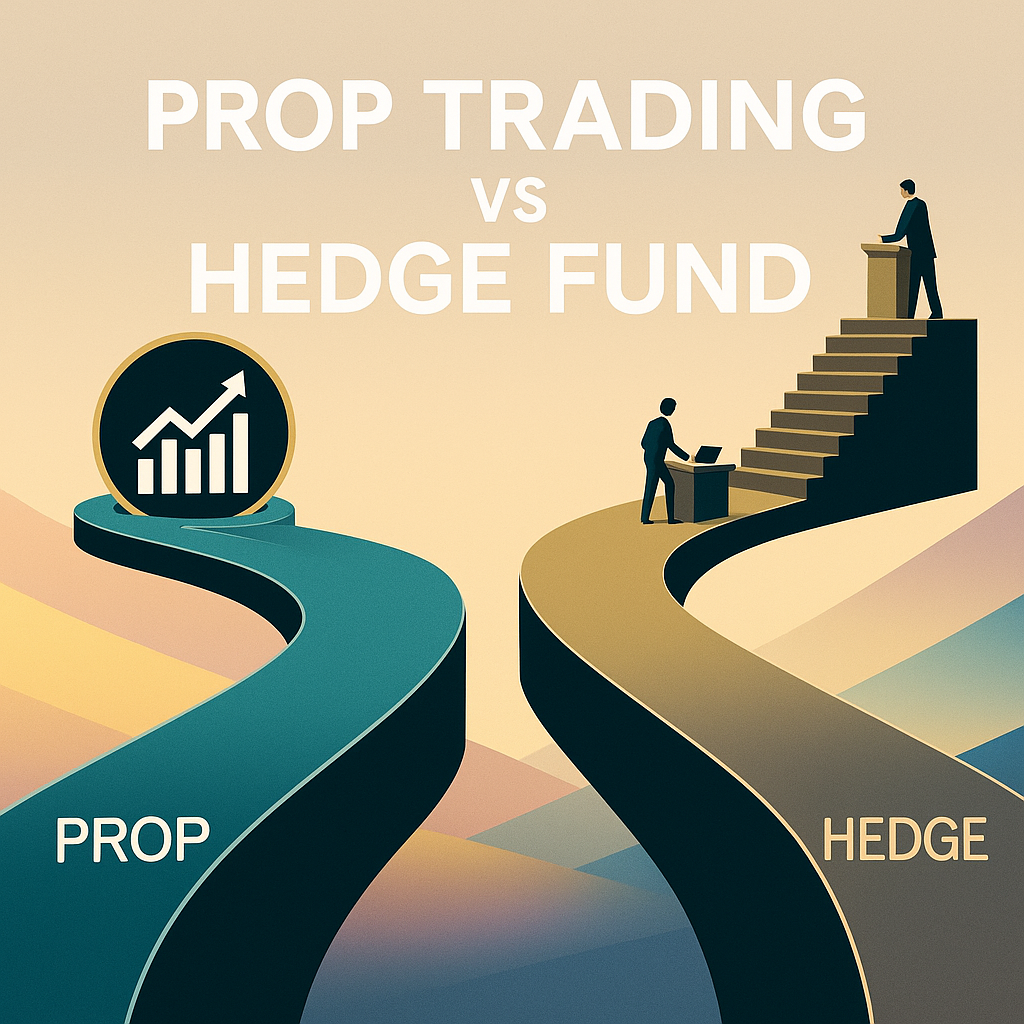Introduction: Understanding Prop Trading vs Hedge Fund Models
In today’s dynamic financial markets, many aspiring traders wonder about the distinctions between prop trading vs hedge fund structures. Both models involve active market participation and sophisticated strategies, yet their goals, risk exposure, and compensation frameworks vary significantly. Understanding these differences can help you decide which path aligns best with your trading career or investment ambitions.
Whether you’re considering joining a proprietary trading firm like Larsa Capital or investing in hedge funds, this article will break down the core contrasts between the two.
1. Definition and Structure: Who’s Trading the Capital?
To begin, let’s define each model:
-
Proprietary Trading (Prop Trading): In this setup, traders use the firm’s capital to trade financial instruments. The firm’s objective is to generate profits from its own trading activities. Traders are often compensated based on performance, and access to capital is a primary benefit.
-
Hedge Funds: These are pooled investment vehicles that manage client assets. Hedge fund managers receive capital from high-net-worth individuals and institutions and earn performance and management fees. The primary goal is to generate returns for investors while managing downside risk.
Although both operate in the financial markets, their capital sources and business models are fundamentally different.
2. Prop Trading vs Hedge Fund: Risk and Reward
Risk Exposure
One of the major differences in prop trading vs hedge fund environments lies in risk ownership. In prop trading, the firm assumes all the risk. Traders are not personally liable for losses unless they violate firm rules. On the other hand, hedge funds handle external client capital, which brings a legal and ethical obligation to preserve and grow those assets responsibly.
Reward Mechanisms
Prop traders are typically paid through profit splits or bonuses tied to their trading results. In contrast, hedge fund managers often earn a “2 and 20” compensation—2% management fee on assets under management and 20% of the profits. This fee structure incentivizes both capital preservation and return generation, but it also creates pressure to deliver consistently.
3. Strategy and Time Horizons
While both entities may use similar trading strategies, their focus often differs:
-
Prop Trading: Emphasizes short-term strategies like scalping, intraday trading, and algorithmic executions. Speed, execution, and leverage matter the most.
-
Hedge Funds: Tend to employ long-term or medium-term strategies such as global macro, long/short equity, or arbitrage. They often incorporate economic trends, geopolitical risks, and diversified portfolios.
Thus, a prop trader may close dozens of trades in a day, whereas a hedge fund could hold positions for weeks or months.
4. Regulation and Transparency
Prop trading firms operate under less regulatory scrutiny compared to hedge funds. Since they don’t manage external funds, their reporting obligations are internal. However, hedge funds must comply with investor disclosure rules, fund registration (in some jurisdictions), and anti-money laundering policies.
This greater transparency can limit the strategies hedge funds pursue, while proprietary traders enjoy more freedom and privacy in execution.
5. Accessibility and Entry Requirements
Getting Into Prop Trading:
Many prop trading firms accept traders with no prior capital, especially those who pass evaluations or trading challenges. At Larsa Capital, for example, new traders can access funded accounts after proving their skills. Entry is performance-based, not capital-based.
Getting Into Hedge Funds:
Entering the hedge fund industry usually requires financial credentials, experience, or connections. For investors, minimum investments often start at $100,000 or more, limiting access to wealthy individuals and institutions.
As a result, prop trading provides a more accessible entry point for retail traders and emerging talent.
6. Control and Autonomy: Who Calls the Shots?
Prop traders typically have more autonomy in day-to-day execution. As long as they follow risk parameters, they can choose strategies, markets, and timeframes. Hedge fund managers, however, work under the pressure of investor expectations, board oversight, and stricter compliance.
This distinction significantly impacts the trading lifestyle, flexibility, and stress levels.
7. Career Paths and Growth Potential
Both models offer lucrative paths, but they differ in growth structure:
-
In prop trading, traders grow by scaling their accounts and increasing profit splits. Some move into mentorship or start their own desks.
-
In hedge funds, professionals progress from analysts to portfolio managers and potentially fund founders, often tied to raising and managing more assets.
So while both environments reward success, the path to growth in hedge funds is more hierarchical and investor-dependent.
Subtitle Using Keyword: Comparing Prop Trading vs Hedge Fund for Aspiring Professionals
When evaluating prop trading vs hedge fund opportunities, consider your personality, risk appetite, and career goals. If you prefer fast-paced environments, direct performance rewards, and greater control, prop trading may suit you better. If you enjoy research-driven decision-making, long-term planning, and investor relations, the hedge fund route may be more appropriate.
Either way, each model provides a legitimate and rewarding career in finance—just through different lenses.
Conclusion: Which Model Fits You Best?
In summary, the debate of prop trading vs hedge fund is not about which is better but which fits your style. Prop trading offers speed, autonomy, and accessibility, making it ideal for skilled traders looking to grow with firm capital. Hedge funds, on the other hand, provide long-term structure, investor alignment, and strategic diversity, suitable for professionals who thrive under institutional frameworks.
Before you choose, reflect on your trading personality, financial goals, and preferred level of responsibility. The right decision can shape not only your career but also your impact in the financial world.

